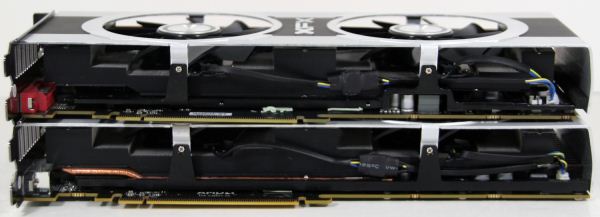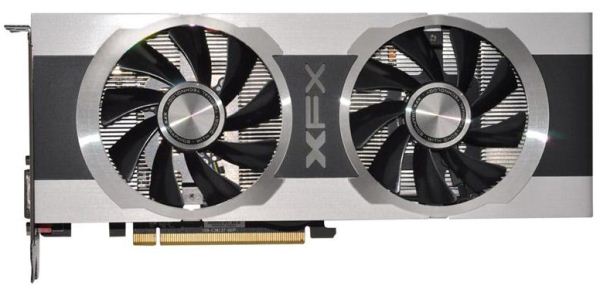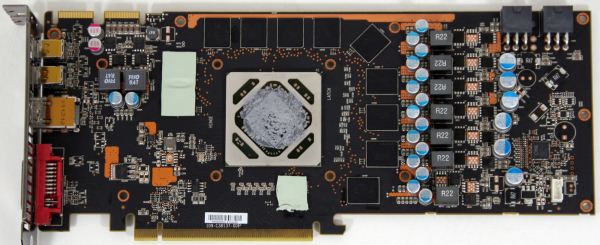AMD Radeon HD 7950 Review Feat. Sapphire & XFX: Sewing Up The High-End Market
by Ryan Smith on January 31, 2012 9:02 AM ESTMeet the XFX R7950 Black Edition Double Dissipation
Our second partner card of the day is XFX’s R7950 Black Edition Double Dissipation. Like the 7970 Black Edition Double Dissipation we reviewed earlier this month, the 7950 BEDD is a factory overclocked card (Black Edition) using XFX’s Double Dissipation cooler.
Starting with the overclock, XFX is shipping the 7950 BEDD with a core clock of 900MHz and a memory clock of 5.5GHz. This represents a 100MHz (12.5%) core clock overclock and 500MHz (10%) memory clock overclock, putting it just shy of the 925MHz core clock the 7970 ships at.
In terms of construction like all of the other 7950 cards launching today XFX is using AMD’s 7950 PCB. This means the PCB measures 10.25” long and features 2 6pin PCIe power sockets towards the rear of the card, while at the front the card uses the AMD standard port configuration of 1 DL-DVI, 1 HDMi, and 2 mini-DisplayPorts. The one notable deviation here from the Sapphire card is that XFX has not included a BIOS selection switch, so the card lacks any kind of ability to easily recover from a bad BIOS flash, and if unlocking proves viable it would not be a good candidate for the process.
Meanwhile cooling is provided by XFX’s Double Dissipation cooler. This is the same heatsink and fan assembly we saw with the 7970 BEDD, which makes this an open air cooler using a pair of fans to push air along an aluminum heatsink running almost the entire length of the card. Because it’s the same assembly, the shrouding for the card sticks out over the end of the PCB, negating the benefit of the shorter 7950 PCB and making the card 10.65” long just like the 7970 BEDD.

Top: 7950 BEDD. Bottom: 7970 BEDD
Do note that while it uses the same fan and heatsink assembly, Double Dissipation does not mean it uses the same vapor chamber assembly to transfer heat from the card. Where the 7970 BEDD used a fairly large vapor chamber, the 7950 BEDD uses a much smaller vapor chamber that only makes contact with roughly half of the heatsink, meaning that heat isn’t being transferred to the extremities of the heatsink nearly as well on the 7950 BEDD. Furthermore the aluminum plate covering the RAM and MOSFETs is poorly sized, leaving parts of the RAM chips (and their thermal pads) exposed. We’ll see how this plays out when we get to our testing, but the 7950 BEDD is clearly not as well built as the 7970 BEDD.
Rounding out the package is the same collection of extras that we saw in the 7970 BEDD. Inside you’ll find the usual driver CD and quick start guide, along with a metal XFX case badge, a mid-length CrossFire bridge, and a passive HDMI to SL-DVI adaptor. All of this is packed in one of XFX’s pleasantly small boxes, which doesn’t use much more space than the card itself.
The MSRP on the 7950 BEDD is $499, $50 over the MSRP for a regular 7950 and making it one of the more expensive 7950s launching today. XFX is offering a base 2 year warranty on the 7950 BEDD, which can be extended to a lifetime warranty by registering the card within 30 days of purchasing it.












259 Comments
View All Comments
MrBungle123 - Tuesday, January 31, 2012 - link
I don't think Anandtech is read by the "average user"... I would assume mostly gamers, enthusiasts, and IT pros here. Besides who buys 1920x1080 monitors? If the monitor isn't 1920x1200 or higher its not worth buying.Ryan Smith - Tuesday, January 31, 2012 - link
Hi poohbear;When drawing out the tests for the current GPU benchmark suite we debated between 1920x1200 and 1920x1080. Ultimately it was decided that 1920x1200 would be more useful for our needs and that 1920x1080 would be unnecessary; 1920x1080 is only slightly lower in resolution, so our 1920x1200 numbers are only slightly worse in performance than they would be with 1920x1080. The two should be treated as the same, as there's generally not nearly enough of a difference to matter.
-Thanks
Ryan Smith
Pantsu - Tuesday, January 31, 2012 - link
It seems there's two choices for 7950, either a 450€+ custom OC card or a "v2" reference cheapo-PCB cards that go for 400€ in Europe. It would certainly be interesting to get a detailed look at how much of a difference that makes. To me those "v2" cards look a bit too nerfed in terms of VRM and cooling.IMO 7950 is priced accordingly and is no question better than a GTX 580 by any metric really. That's enough to justify a similar price. It's up to Nvidia to drop the GTX 580 price to compete, but I doubt they'll do that, and instead wait for GK104 to save the day. If it is a success we could see prices drop fast in the high end, but Nvidia isn't known for its low pricing, and neither does it have any need to try grab market share by undercutting its profits. There's a good cap between 7800 and 7900 and they could just occupy it with a GK104 and call it a day, until they get their big chip ready.
marc1000 - Tuesday, January 31, 2012 - link
Any word on 7870 from amd?UMADBRO - Tuesday, January 31, 2012 - link
Feb 15marc1000 - Tuesday, January 31, 2012 - link
Ty!just4U - Tuesday, January 31, 2012 - link
That Sapphire cooler looks pretty much like their Dirt3 Edition 6950s one. A slightly different plastic shroud but fan's and underlay seem mostly the same.. atleast in the picture views I've seen.gamoniac - Tuesday, January 31, 2012 - link
I found that, in IE 9, I have to click on the "Back" button on the browser six to seven times to actually go back to the main page. Taking a closer look at it, I noticed there are a bunch of "Share this Page" history item between this page (Ryan's HD7950 Review) and the main page that took place without my knowledge. Would this be a site bug or a advertisement bug?Ryan Smith - Tuesday, January 31, 2012 - link
To the best of my knowledge (please keep in mind that I'm not responsible for site development), that's not something the site should be doing. In which case it could very well be an ad bug. If it continues to happen you should be able to use the IE9 developer tools (built-in, F12), to try to narrow down what exactly it is you're seeing.gamoniac - Tuesday, January 31, 2012 - link
Without spending too much time on it, I can see that there were a bunch of frame navigation caused by sharethis.com, which I think is the likely culprit. I am able to reproduce this issue on two separate Win7 SP1 machines; one of them is clean with almost installed except for the usual PDF reader and some benchmarking tools.Check out these three images I uploaded:
In the beginning:
http://i43.tinypic.com/nqwgti.jpg
Problem captured:
http://i44.tinypic.com/jai5gk.jpg
IE9 F12 screen shot showing frame navigation:
http://i44.tinypic.com/14y226q.jpg
Good luck.